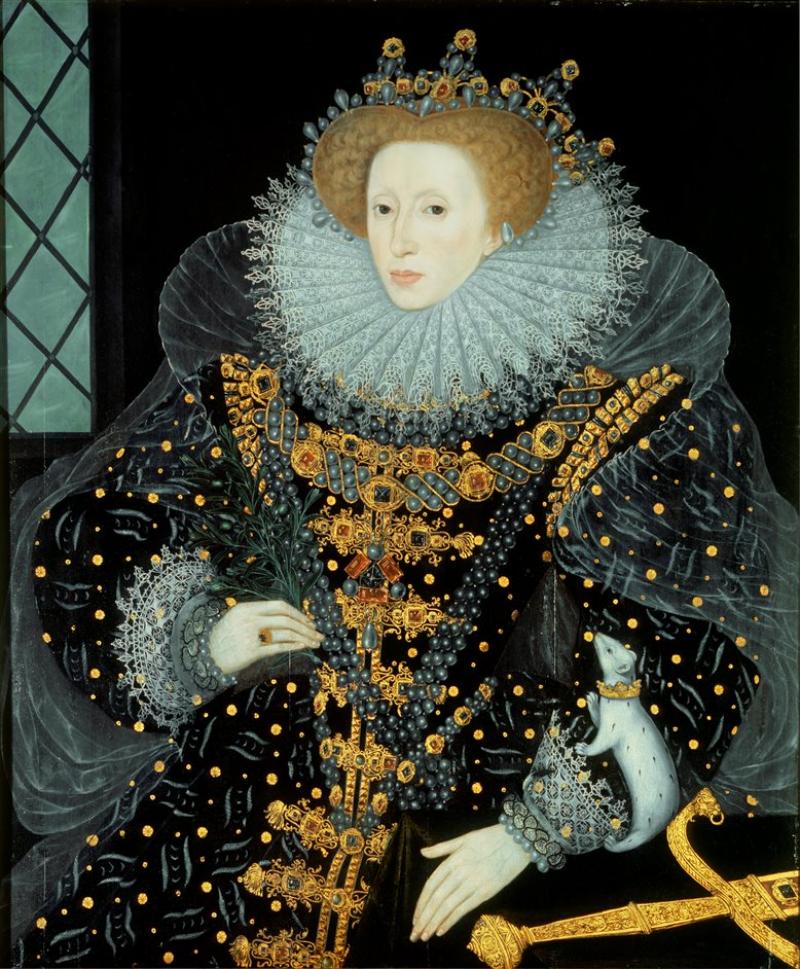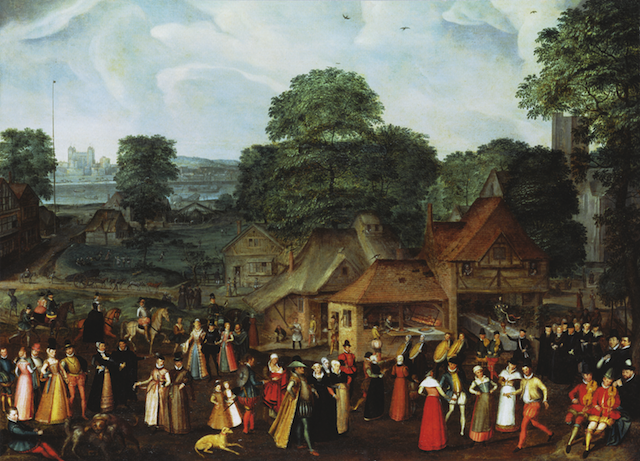Elizabeth I and Her People, National Portrait Gallery | reviews, news & interviews
Elizabeth I and Her People, National Portrait Gallery
Elizabeth I and Her People, National Portrait Gallery
A captivating crash course in Elizabethan history, its shadows and its glories

At the beginning of the 17th century an anonymous Anglo-Netherlandish artist produced an elaborate procession portrait of the septuagenarian Virgin Queen, tactfully portrayed as though several decades younger, when she had succeeded to the throne in her mid-twenties. Elizabeth I is held aloft under an embroidered canopy and surrounded by Knights of the Garter, courtiers, members of the royal household, and aristocrats.
Half fantasy, half reality, the parade reflects the kind of royal procession that was a feature of the Elizabethan court, confirming both wealth and power as the Queen and her entourage journeyed through her kingdom.
Portraiture glorified the splendours of dress in rigidly codified fashion, but faces could be highly individualised
This detailed painting, a vividly theatrical tableau, sets the scene for this glimpse into an era that many historians define as the beginning, perhaps surprisingly, of modern England. Over the century London more than doubled in size, with a population of 200,000 by 1600. At the same time, there was an exponential growth of – guess what! – lawyers, as many proportionately as in the 1970s. Battles were won, notably of course the defeat of the Spanish Armada, an empire was initiated, trade advanced, mercantile fortunes were in the ascendant, the Bible appeared in English and Protestantism reigned, and the first playhouses emerged as well as a dazzling efflorescence of poetry. All are suggested by the array of portraits, many of them substantial, on view.
Indeed here is a dramatic portrait of John Donne, all swirling blacks, intensely melancholy and illuminating his long-fingered left hand and his unconventional open necked shirt. It is a surprisingly sensual painting “taken in shadows” as the poet himself said. We sense the emotional turmoil of the infatuated lover.
Then as now the rich were getting richer – 55 hereditary peers at the top of the pile, followed by knights, gentry, esquires, gentlemen, all running Parliament and the justice system, and of course the court itself, and owning two thirds of the country. But the middling classes were rising, too, while the status of the poor was dismal and getting worse. We have to infer their circumstances from documents and literature, as there is hardly any surviving material culture to show their stories, although Joris Hoefnagel’s 1560s painting of a Fête at Bermondsey (pictured below), with the Tower of London just visible, shows cooks and maids, watermen, a porter, carpenters and a man driving a cart. There are ubiquitous dogs, and of course Bermondsey seems more farmland than city. So this visual tale is perforce a story of the successful, even if for some who incurred the royal wrath, heads would roll.
 The National Portrait Gallery’s exhibition does just what its title says. It's an artful examination through marvellously detailed portraits of the grand and the up-and-coming middle classes, accompanied by exquisite portrait miniatures, clothing from ornately decorated gloves to a child’s bootee, a jewelled pomander, a rapier, a wheel-lock pistol damascened with silver and gold and completed with an engraved antler, a finely worked set of drawing instruments in brass, steel and wood, Renaissance rings of gold and gemstones, an ivory comb and a glittering small purse in the shape of a frog.
The National Portrait Gallery’s exhibition does just what its title says. It's an artful examination through marvellously detailed portraits of the grand and the up-and-coming middle classes, accompanied by exquisite portrait miniatures, clothing from ornately decorated gloves to a child’s bootee, a jewelled pomander, a rapier, a wheel-lock pistol damascened with silver and gold and completed with an engraved antler, a finely worked set of drawing instruments in brass, steel and wood, Renaissance rings of gold and gemstones, an ivory comb and a glittering small purse in the shape of a frog.
The ideal of feminine beauty from the Queen on down meant very high foreheads, thin, exaggeratedly arched eyebrows, whitened faces; men were almost invariably bearded in a variety of styles. All had unbelievable wasp waists, set off for the women by very wide skirts. The portraits contain a wealth of symbolic information and heraldic devices, elaborations which were easily read by contemporaries: the portrait of Sir Walter Raleigh is festooned with depictions of pearls, symbolising both the Virgin Queen and the poet-explorer’s devotion to his sovereign.
A rare Raleigh manuscript, from Hatfield House, its writing perfectly legible (a poem to Cynthia, the moon goddess) is also on view and seems to be part of a cycle he wrote when he disastrously fell from favour on the occasion of his secret marriage to one of the Queen’s ladies-in-waiting. Court passions ran high, and none were allowed to rival Her Majesty.
Here are characters galore; the standard of portraiture glorified the splendours of dress in rather rigidly codified fashion, with clear clues as to the status of the wearer, but faces could be highly individualised. Nicholas Hilliard’s alluring miniature shows the “cheerefull countenance” of Sir Francis Drake who, on his long voyages, mostly as a privateer, brought back much wealth. A full-scale portrait by Anonymous of Bess of Hardwick, widowed four times and a woman of immense wealth, shows us an assured and determined redhead.
The strength of this choice exhibition is to show through art, much of it rare survivors, the intertwining of politics, society and culture. It is a captivating crash course in Elizabethan history, its shadows and its glories.
- Elizabeth I and Her People at National Portrait Gallery until 5 January 2014
Share this article
The future of Arts Journalism
You can stop theartsdesk.com closing!
We urgently need financing to survive. Our fundraising drive has thus far raised £49,000 but we need to reach £100,000 or we will be forced to close. Please contribute here: https://gofund.me/c3f6033d
And if you can forward this information to anyone who might assist, we’d be grateful.

Subscribe to theartsdesk.com
Thank you for continuing to read our work on theartsdesk.com. For unlimited access to every article in its entirety, including our archive of more than 15,000 pieces, we're asking for £5 per month or £40 per year. We feel it's a very good deal, and hope you do too.
To take a subscription now simply click here.
And if you're looking for that extra gift for a friend or family member, why not treat them to a theartsdesk.com gift subscription?
more Visual arts
 'We are bowled over!' Thank you for your messages of love and support
Much-appreciated words of commendation from readers and the cultural community
'We are bowled over!' Thank you for your messages of love and support
Much-appreciated words of commendation from readers and the cultural community
 Lee Miller, Tate Britain review - an extraordinary career that remains an enigma
Fashion photographer, artist or war reporter; will the real Lee Miller please step forward?
Lee Miller, Tate Britain review - an extraordinary career that remains an enigma
Fashion photographer, artist or war reporter; will the real Lee Miller please step forward?
 Kerry James Marshall: The Histories, Royal Academy review - a triumphant celebration of blackness
Room after room of glorious paintings
Kerry James Marshall: The Histories, Royal Academy review - a triumphant celebration of blackness
Room after room of glorious paintings
 Folkestone Triennial 2025 - landscape, seascape, art lovers' escape
Locally rooted festival brings home many but not all global concerns
Folkestone Triennial 2025 - landscape, seascape, art lovers' escape
Locally rooted festival brings home many but not all global concerns
 Sir Brian Clarke (1953-2025) - a personal tribute
Remembering an artist with a gift for the transcendent
Sir Brian Clarke (1953-2025) - a personal tribute
Remembering an artist with a gift for the transcendent
 Emily Kam Kngwarray, Tate Modern review - glimpses of another world
Pictures that are an affirmation of belonging
Emily Kam Kngwarray, Tate Modern review - glimpses of another world
Pictures that are an affirmation of belonging
 Kiefer / Van Gogh, Royal Academy review - a pairing of opposites
Small scale intensity meets large scale melodrama
Kiefer / Van Gogh, Royal Academy review - a pairing of opposites
Small scale intensity meets large scale melodrama
 Jenny Saville: The Anatomy of Painting, National Portrait Gallery review - a protégé losing her way
A brilliant painter in search of a worthwhile subject
Jenny Saville: The Anatomy of Painting, National Portrait Gallery review - a protégé losing her way
A brilliant painter in search of a worthwhile subject
 Abstract Erotic, Courtauld Gallery review - sculpture that is sensuous, funny and subversive
Testing the boundaries of good taste, and winning
Abstract Erotic, Courtauld Gallery review - sculpture that is sensuous, funny and subversive
Testing the boundaries of good taste, and winning
 Edward Burra, Tate Britain review - watercolour made mainstream
Social satire with a nasty bite
Edward Burra, Tate Britain review - watercolour made mainstream
Social satire with a nasty bite
 Ithell Colquhoun, Tate Britain review - revelations of a weird and wonderful world
Emanations from the unconscious
Ithell Colquhoun, Tate Britain review - revelations of a weird and wonderful world
Emanations from the unconscious
 Rachel Jones: Gated Canyons, Dulwich Picture Gallery review - teeth with a real bite
Mouths have never looked so good
Rachel Jones: Gated Canyons, Dulwich Picture Gallery review - teeth with a real bite
Mouths have never looked so good

Add comment